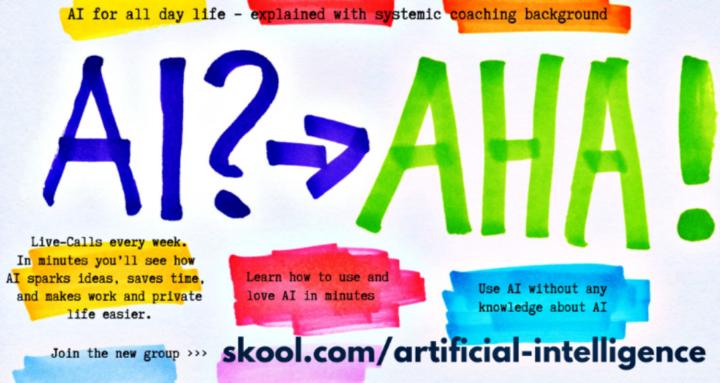
Write something
Welcome to the new members and hello to all of you!
Welcome (some of you: again) and good to have you here in this community! Post your Social Media profile and your website in the comments and interconnect 🤝 👏 👥 ☀️ Terrie Gholston Anthony Earp Bansari Panchal Usman Karamat Stephen Corpas Holger Peschke 🔥 (the flame makes me link to the Level-up-Article) Kris Pothana Mwanjo Molongo Germans Frolovs Joel Wilson Abdurrahman Ibrahim Frances P Sd N Future of Work Professor Pei Mei Mick Holloway Camila Drego Manuel Betancurt Shawn S Ivan Wong Sylvia Sara
How to level up in a Skool-Community
To level up in a Skool community, focus on consistent, high-value engagement: – Post helpful content that sparks discussion or solves a common problem. – Comment meaningfully on other members’ posts to build relationships. – Show up regularly — short daily interactions matter more than rare long ones. – Ask thoughtful questions that invite shared experience and insight. – Support others' progress — give feedback, encouragement, or tools they can use. Skool rewards relevance, reliability, and relational behavior. Be visible for the right. Be the best reason for other members to be here .... Photo credit: You see my picture of „Bayerische Staatsbibliothek, Munich, Germany“ (a wonderful place to stay forever for a day at least.)

Why does AI confidently state false information?
Why does AI confidently state false information? Models cannot distinguish between true and false - they generate statistically likely text. This is a proof that in AI is no intelligence in a narrow sense. The confidence illusion within AI Large language models rely on transformer-based architectures that optimize token likelihood but ignore ontological grounding, so the generated outputs resemble plausible knowledge graphs rather than verified fact-structures. This creates the origin for AI_hallucinations, semantic drift, and unintended consequences, when AI systems enter domains with high-stakes decision-making such as healthcare diagnostics, jurisprudence, corporate auditing, or scientific publishing. The illusion of credibility is amplified by semantically clustered n-grams like “evidence shows,” “the data confirms,” or “studies prove,” which co-occur with domain-specific entities in the training corpus, thereby reinforcing a false perception of validity. Training data contains authoritative writing style. Models learn to mimic confidence markers ("clearly," "obviously," "certainly") without understanding truth. The lack of understanding is equal with the absence of real intelligence. Psychology research shows humans trust confident-sounding AI 65% more than uncertain AI, even when wrong. A typical sign for confirmation bias. "If it seems plausible, it is, for sure ..." Real-world consequences: - Medical misdiagnosis from AI tools - Legal briefs with fictional citations - Financial advice causing losses - Educational misinformation spread This phenomenon reflects a multidimensional interplay between truth validation, epistemic uncertainty, and linguistic probability distributions. Large language models rely on transformer-based architectures that optimize token likelihood but ignore ontological grounding, so the generated outputs resemble plausible knowledge graphs rather than verified fact-structures. This creates the origin for AI_hallucinations, semantic drift, and unintended consequences, when AI systems enter domains with high-stakes decision-making such as healthcare diagnostics, jurisprudence, corporate auditing, or scientific publishing.
0
0

Is AI destroying the internet with AI-generated content?
Is AI destroying the internet with AI-generated content? No, AI is not destroying the internet. But: Model collapse threatens future AI development as training on synthetic data degrades performance. Reads: If a new model is trained on weak data, the new model is weak from the beginning. The next model is trained on the last weak model again. This is reducing the general evidence of information. Content becomes suspicious but seems to be plausible. Research from Oxford (2024) demonstrates: - Models trained on AI-generated text lose 30% accuracy within 5 generations - Creative writing becomes homogenized - Rare information disappears from outputs - Bias amplification accelerates – hallucination increases Current internet pollution: - 50%+ of some article sites are AI-generated (NewsGuard estimate) - Amazon is flooded with AI-written books - Social media bot content is exceeding human posts - Academic papers containing AI text rising 15% yearly Long-term risk: Future models trained on corrupted internet data will be fundamentally broken. What to do if you want to be sure (you should want this): Check every text, every paragraph and website before you believe – here is the AI-Agent that will check any result. You find this in the classroom. ---
0
0

Why can't AI explain its decisions?
Why can't AI explain its decisions? Neural networks operate as black boxes with billions of parameters interacting in incomprehensible ways. The opacity problem: If a LLM has 1.76 trillion parameters, no human can interpret how these weights combine to produce specific outputs. The European AI Act requires explainability for high-risk applications, but current LLMs cannot comply. Research from MIT CSAIL shows: - Mechanistic interpretability captures <1% of model behavior - Attention visualizations misleading for understanding reasoning - Post-hoc explanations often inaccurate rationalizations Implications: Cannot debug errors systematically, impossible to guarantee behavior, liability unclear when harm occurs, audit requirements unmet. Find more: AI Concerns Addressed.
0
0

1-16 of 16

skool.com/artificial-intelligence
Artificial Intelligence (AI): Machine Learning, Deep Learning, Natural Language Processing NLP, Computer Vision, ANI, AGI, ASI, Human in the loop, SEO
Powered by



